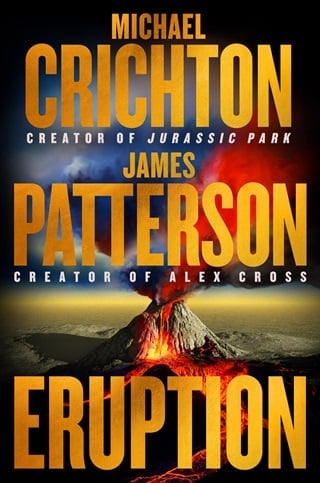Chapter 7
Back in the data room, MacGregor was greeted with complete silence; it was almost as if everyone were making a concerted effort to ignore him.
Kenny Wong, the lead programmer, was busy typing and did not look up. Rick Ozaki, the seismologist, was busy enlarging the data on his screen. Pia Wilson, the woman in charge of the volcano alert levels, was busy working at the back of one of her monitors. MacGregor stood there a moment, waiting. He hadn't expected a standing ovation but he also hadn't expected to hear nothing but the tapping of keys.
He walked over to Kenny Wong, sat down, pushed Kenny's bag of potato chips and Diet Coke cans to one side, put his arms on the table, and said, "Well?"
"Nothing." Kenny shook his head, kept typing.
"There has to be something."
"There's not."
"Kenny…"
Kenny looked up at him with hard eyes. "Okay, here's something, Mac: Why didn't you tell them?"
"Tell them what?"
"That it's going to be the biggest damn eruption in a century."
"C'mon, man, you know we talked about this," MacGregor said. "They're reporters, and we both know they'd blow it out of proportion—they'd be the ones erupting. And I don't want to make a prediction like that and have it be wrong."
"But you know it won't be wrong," Kenny said. He was wounded and angry, and he made no effort to edit his words for his boss. "There's no way it could be wrong. The computer models have been consistent for thirty-seven straight weeks. You come on, Mac. Thirty-seven frigging weeks. That's longer than the baseball season."
"Kenny," MacGregor said. "In 2004, the head of HVO predicted an eruption of Mauna Loa that never happened. Don't you think his programmers swore to him that it was a sure thing?"
"I wouldn't know," Kenny said. "I wasn't even born yet."
"Yeah, you were," Mac corrected him. "And please stop being so dramatic."
Their lead programmer was twenty-three years old. Brilliant, frequently childish, given to fits of pique, particularly when he had been up all night. Which was most of the time.
Across the room, Rick called out, "Mac, you might want to look at this." The seismologist—thirty, bearded, heavyset, wearing jeans and a black Hirano Store T-shirt—was slow-moving and thoughtful, the opposite of the hotheaded Kenny Wong. Rick pushed his glasses farther up the bridge of his nose as MacGregor came over.
"What've you got?"
"This is the summarized seismic output for last month, filtered for artifact noise." The screen showed a dense pattern of squiggles, the data transmitted by the seismometers positioned around the island.
"So?" MacGregor shrugged. "These are typical tremor swarms, Rick. High frequency, low amplitude, long duration. We have them all the time now. What am I missing here?"
"Well, I've been doing second order on this," Rick said, typing as he spoke. "The hypocenters cluster around the caldera and north slope. The fit to data is perfect. Like, perfect. So I think there's an opportunity that we ought to talk about—"
They were interrupted by a loud thumping sound that built rapidly, shaking the floor of the laboratory and rattling the glass. A helicopter appeared in the window, frighteningly close and low; it rushed past them and swooped down into the caldera.
"Sweet Jesus!" Kenny Wong yelled, running to the window to get a better look. "Who is that asshole?"
"Get the tail number," MacGregor snapped, "and call Hilo ASAP. Whoever that idiot is, he's going to give one of the tourists a haircut. Damn!" He went to the window and watched as the helicopter dropped low and thumped its way across the smoking plain of the caldera. The pilot couldn't be more than twenty feet above the ground.
Beside Mac, Kenny Wong watched through binoculars. "It's Paradise Helicopters," he said, sounding puzzled. Paradise Helicopters was a reputable operation based in Hilo. Their pilots ferried tourists over the volcanic fields and up the coast to Kohala to look at the waterfalls.
MacGregor shook his head. "They know there's a fifteen-hundred-foot limit everywhere in the park. What the hell are they doing?"
The helicopter swung back and slowly circled the far edge of the caldera, nearly brushing the smoking vertical walls.
Pia cupped her hand over the phone. "I got Paradise Helicopters. They say they're not flying. They leased that one to Jake."
"Is there any news at the moment I might like?" Mac said.
"With Jake at the controls, there is no good news," Kenny said.
Jake Rogers was an ex-navy pilot known for breaking the rules. After two FAA warnings in a year, he had been fired by his tour company, and now he spent most of his time in a seedy bar in Hilo. "Apparently Jake's got a cameraman from CBS with him, some stringer from Hilo," Pia said. "The guy's pushing for exclusive footage of the new eruption."
"Well, there's no eruption in there," MacGregor said, staring at the caldera. The Kīlauea caldera—what most people called the crater—had been a tourist attraction in Hawai‘i since the nineteenth century; Mark Twain, among other notables, had stood looking down into the huge smoking pit. Today there was steam and sulfur and other evidence of volcanic activity, but there hadn't been an actual eruption from the caldera in twenty years. All the recent lava flows from Kīlauea had come from the volcano's flanks, miles to the south.
The helicopter rose out of the caldera, scattering tourists at the railing, roared above the observatory, and made a broad circle. Then it thump-thump-thumped off to the east.
"Now what?" Rick asked the room.
"Looks like he's going to the rift zone," Kenny said. "And what good can come of that?"
"None," MacGregor said, still standing at the window.
Jenny Kimura came in. "Who is that guy? Is somebody calling Hilo?"
MacGregor turned to her. "Are the reporters still here?"
"No, they left a few minutes ago."
"Didn't I make it clear the eruption hasn't started yet?"
"I thought you made that abundantly clear, yes."
"Mac, this guy's a stringer," Rick said. "He wasn't at the press conference. He's trying to get ahead in the world. You know what they say: Don't worry about being right, just being first."
"Hey, Mac? You're not going to believe this." Pia Wilson, at the main video panel, flicked on all the remote monitors to show the eastern flank of Kīlauea. "The pilot just flew into the eastern lake at the summit of Kīlauea."
"He what?"
Pia shrugged. "See for yourself."
MacGregor sat down in front of the monitors. Four miles away, the black cinder cone of Pu‘u‘ō‘ō—the Hawaiian name meant "Hill of the Digging Stick"—rose three hundred feet high on the east flank. That cone had been a center of volcanic activity since it erupted in 1983, spitting a fountain of lava two thousand feet into the air. The eruption continued all year, producing enormous quantities of lava that flowed for eight miles down to the ocean. Along the way, it had buried the entire town of Kalapana, destroyed two hundred houses, and filled in a large bay at Kaimūī, where the lava poured steaming into the sea. The activity from Pu‘u‘ō‘ō went on for thirty-five years—one of the longest continuous volcanic eruptions in recorded history—ending only when the crater collapsed in 2018.
Tourist helicopters scoured the area looking for a new place to take pictures, and pilots discovered a lake that had opened to the east of the collapsed crater. Hot lava bubbled and slapped in incandescent waves against the sides of a smaller cone. Occasionally the lava would fountain fifty feet into the air above the glowing surface. But the crater containing the eastern lake was only about a hundred yards in diameter—much too narrow to descend into.
Helicopters never went inside it.
Until now.
"What the hell?" Jenny said.
Mac said, "That is hell."
 Fullepub
Fullepub 



